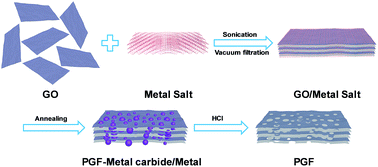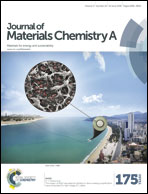A universal strategy to prepare porous graphene films: binder-free anodes for high-rate lithium-ion and sodium-ion batteries†
Abstract
Porous graphene films (PGFs) were developed by introducing defects and extra edges into graphene using GO and a metal salt (ferric nitrate) as sources via a facile filtration method together with a thermal reduction and subsequent removal of the metal. The pore size and density could be controlled by simply adjusting the amount of ferric nitrate. When used as an anode for lithium ion batteries, PGF-1 showed a high reversible capacity, improved cycling stability, and ultra-high rate performance (971, 298, and 163 mA h g−1 at the rates of 10, 30, and 50 A g−1 after 10 000 cycles). When used as an anode for sodium ion batteries, PGF-1 showed a reversible capacity of 195 mA h g−1 at 50 mA g−1 after 50 cycles. Even at a high rate of 1000 mA g−1, the reversible capacity can still remain at 111 mA h g−1 after 1000 cycles. The excellent performance should be attributed to the special porous structure of the PGF. On one hand, plenty of defects within the PGF provided extra reaction sites for lithium and sodium ion storage. On the other hand, the porous structure of the PGF resulted in fast diffusion and transfer of lithium/sodium ions and electrons throughout the electrodes.


 Please wait while we load your content...
Please wait while we load your content...